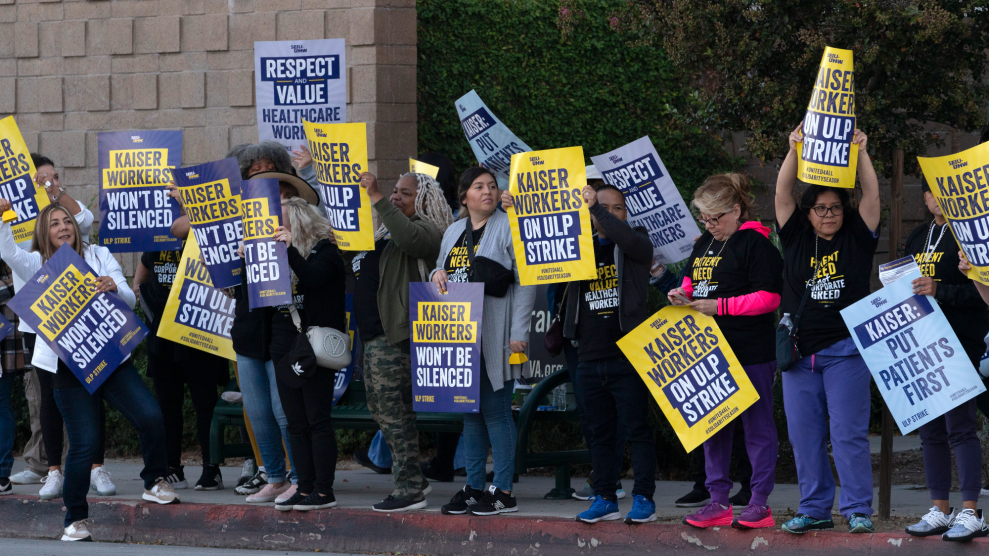Over the past month and a half, U.S. planes and Iraqi anti-aircraft missiles have squabbled so often, it’s easy not to notice them anymore. On Monday, ignoring them became a bit harder. U.S. anti-radar missiles missed their targets and killed at least 11 civilians; a reminder that even guided missiles cause civilian deaths.
Unlike this week’s missile firings, the United States’ four-day December campaign against Iraq resulted in wildly varying reports about the number of civilians who were killed or wounded. The Pentagon went so far as to claim that it had “no evidence of civilian casualties” from Desert Fox, a fact it attributed to the precision accuracy of American missiles. High-tech weaponry probably did reduce the number of casualties. But, as the MoJo Wire found out, the lack of hard numbers may also have been a result of something less impressive: lack of information.
On December 16, 1998, American forces began bombing Iraq because of its refusal to allow the United Nations to conduct on-site inspections for weapons of mass destruction. That night, the MoJo Wire published a commentary on the attack by Howard Zinn, professor emeritus of history at Boston University and author of A People’s History of the United States. A few days later, Professor Zinn received an extraordinary response to his commentary by Dr. Mohammed Al-Obaidi, a former Iraqi citizen living in exile in Britain. “During the second day of bombarding Iraq,” Dr. Obaidi wrote, “a cruise missile hit my parents’ house in the suburb of Baghdad, where my mother, my sister-in-law (wife of my deceased brother), and her three children were all killed.”
Dr. Obaidi’s claim astonished us. If his story was true, why hadn’t we heard about civilian casualties from Desert Fox, since the recent ones were well-reported? We decided to check out Dr. Obaidi’s story.
Dr. Obaidi says he escaped from Iraq, where he was vocally opposed to the regime of Saddam Hussein, in 1985, leaving behind his father, mother, two brothers, and three sisters. We verified that he landed in Britain, where he was granted “exceptional leave” status (a.k.a. political asylum) by the British and received his Ph.D. from Leeds University in cardiovascular physiology.
Dr. Obaidi says that his mother and four other family members lived in a house in a northeastern suburb of Baghdad, in the Al-Kadhimiah district. According to his account, there was a military installation, with a radar used to detect enemy planes, located 500-600 yards away from the house. When reports that the U.S. might attack first circulated, Obaidi’s brother, who lives in Iraq, tried to get their mother and sister-in-law to move to his house temporarily. But Obaidi says his mother declined.
According to Obaidi, on the night of December 17th, a cruise missile hit his mother’s house, killing five of Obaidi’s relatives and 22 others in the area, and wounding 37 more. Obaidi’s brother went to the site the next day and said the missile had created a hole 20 feet deep in the ground.
Obaidi says he tried to call his mother during the attack, but “the line was dead.” Later, another one of Obaidi’s brothers, who lives in Germany, flew to Iraq to investigate and went to the site to try to collect the bodies of his family members. But “[rescue workers] were unable to collect the remains of innocent people who were killed,” Obaidi says. “Even after the funeral, they found pieces of bodies, and a hand here and a thumb there.”
The MoJo Wire contacted the Pentagon’s U.S. Central Command, the office responsible for overseeing Middle East operations, to see whether it had any evidence of such an incident. Major Joe Lamarca, a spokesman for the command, said there is “no evidence of civilian casualties.” When asked if the radar site that Dr. Obaidi described could have been a target, Lamarca said, “We very well could have attacked a radar site. That was one of the types of targets that we went after.” But he wouldn’t elaborate on specific sites, citing security reasons.
The MoJo Wire also spoke with Scott Peterson, Middle East correspondent for the Christian Science Monitor and one of the few Western journalists in Iraq during the strikes. He said the Iraqis were very forthcoming about leading the press corps to residential sites that were hit. After all, Peterson said, it was “in Iraq’s best interest” for the world to see civilian casualties, in order to create sympathy for Iraq. At one site, Peterson said, a bomb had hit in the middle of a road in the Kadhimiah district (the same district where Obaidi’s mother lived). At another, a hospital’s windows had been shattered due to the force of a nearby bomb.
When we related Obaidi’s story to Peterson, he said he found it unlikely that Iraqi officials would not have led the press to a site where 27 people had been killed and 37 injured. “If that happened, I would have expected that we would have been taken to that site, and we would have all been interviewing those people the next day,” Peterson said.
However, Peterson added that there are a number of reasons why the Iraqis might not have led the press to such a site: the casualties may have been dispersed to different hospitals, or they may have not known about that site at the time. It was also possible, Peterson said, that the Iraqis might not have wanted to give the U.S. or Britain information about the radar installation next to the damage — especially if errant missiles had left the radar intact. “The fact that we weren’t taken there doesn’t mean it didn’t happen,” he said.
Peterson said he saw the impact of a cruise missile that had hit dirt in a field and left a crater about 20 feet deep. As for the possibility that the incident may have resulted from “friendly fire,” he says there is “no way” anti-aircraft missiles that fell to the ground could have left this indentation.
When we dug further into the question of civilian casualties, we found that, for differing reasons, nobody seemed to have a good count.
According to the Pentagon’s U.S. Central Command, both U.S. and British ordinance hit 85 percent of their targets. When we asked what happened to the 15 percent that didn’t hit their targets, they said some of the missiles were never released because of malfunctions or bad weather, and another portion simply missed their targets. The Pentagon did not have further breakdowns between the two categories.
The reports that quoted initial figures were wildly erratic. On December 20th, Iraq’s United Nations envoy, Nizar Hamdoon, said the number of dead and injured ran into the thousands. The next day, Tariq Aziz, Iraq’s deputy prime minister, said the civilian casualties were “much, much higher than the military casualties,” but didn’t give a figure. Aziz said military casualties totaled 62 killed, 180 wounded.
According to the Washington Post on January 9th, “Iraqi officials said after the attacks that most casualties had been civilians and placed the number at as many as 70.”
When asked his best educated-guess about civilian casualties due to Desert Fox, Peterson said, “I would find it hard to believe that there would be more than 100 total.” Peterson said that except for Hamdoon’s figure of “many thousands,” the Iraqi government had been responsible about reporting casualties.
“The Iraqis were not exaggerating figures by any stretch,” Peterson said.
The MoJo Wire contacted the Iraqi mission to the United Nations, but they could not provide any additional information.
We tried getting figures on civilian casualties through the Red Cross, which is the most reliable source journalists have for civilian deaths in military engagements. But they didn’t have any numbers. The reason: Iraq did not allow the Red Cross to enter the country after the bombings.
The United Nations’ press office also had “no idea” about the number of casualties, adding that the Iraqis had not announced an official figure.
“It was probably hard for them to know exactly how many civilian casualties there were,” Peterson said. “You can’t really know; probably no one will ever know.”











